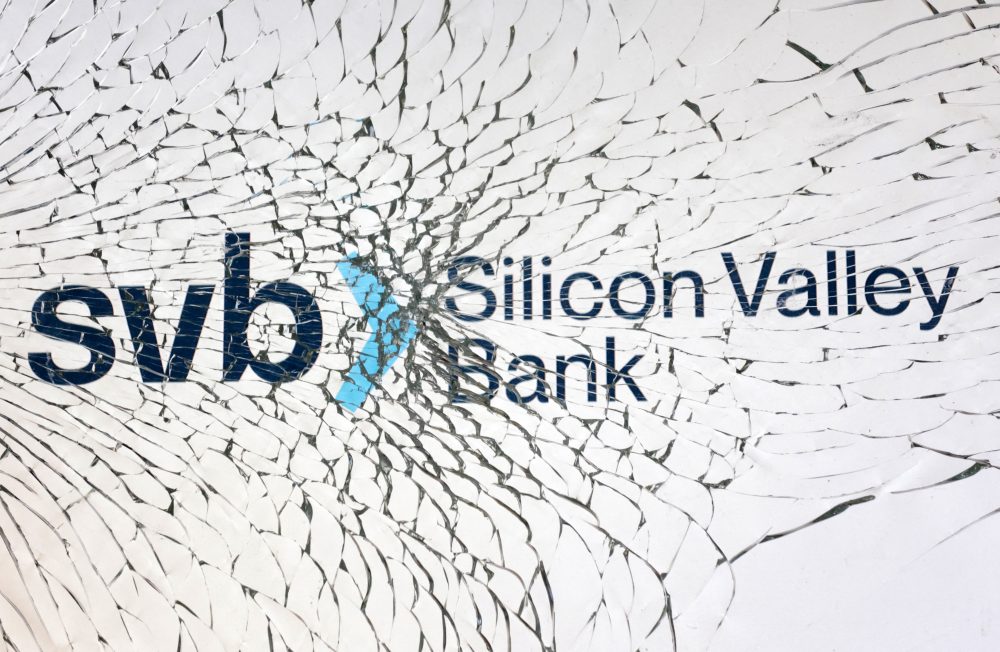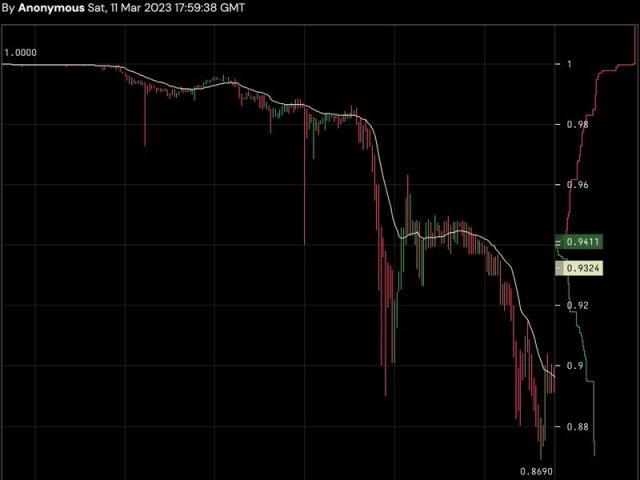Following Sillicon Valley Bank’s failure, information that Circle, the company that issues the USDC stablecoin, owned $3.3 billion in SVB reserves caused concern that the stablecoin was no longer completely supported. Although we are confident in the security of Circle’s reserves as of Sunday night, both centralized and decentralized marketplaces crashed down over the weekend.
A lot of people panicked and tried to save their money. There were more rumours and speculations, but let’s see exactly what happened and what the impact could be!


When owners hurried to redeem their tokens after finding that Circle had held a portion of the money underpinning USDC at Silicon Valley Bank, which state and federal officials had taken over on Friday morning, the Circle-issued stablecoin lost value late Friday.
The California Department of Financial Protection and Innovation closed Silicon Valley Bank (SVB) on Friday, making it the second bank to do so in recent days.
In a statement, the DFPI said that it had taken control of the bank due to “inadequate liquidity and bankruptcy.” The bank has been placed under the Federal Deposit Insurance Corporation’s receivership, according to DFPI, which the FDIC verified.
Following closely on the footsteps of rival Silvergate’s voluntary insolvency earlier this week, the bank has closed. All deposits will be refunded, according to a statement made earlier this week by holding firm Silvergate Inc. (SI).
The technologically advanced Silicon Valley Bank has a number of crypto organizations as clients, particularly hedge funds and venture capital businesses, despite not being seen as being as “crypto-friendly” as Silvergate. Blockchain Capital, Castle Island Ventures, Dragonfly, and Pantera all reportedly had connections with the bank, according to CoinDesk analysis.
The dashboard for the bank, which is supposed to display “account balances and money transactions,” was down, an SVB client in the UK told Reuters.
With $211 billion in assets, SVB’s bankruptcy is among the biggest in history, coming in second only to Washington Mutual Bank’s failure in the 2008 Great Financial Crisis.
Silicon Valley Bank (SIVB), the institution that was shut down by authorities earlier in the day after seeing a run on deposits, still had $3.3 billion in cash deposits, according to stablecoin issuer Circle late on Friday. The amount is about 8% of the entire reserves supporting USDC, Circle’s stablecoin.
One of Circle’s six banking partners, Silicon Valley Bank, held some of the reserve assets supporting its $40 billion USD stablecoin.
“Circle is currently protecting USDC from a black swan failure in the U.S. banking system,” Dante Disparte, Circle’s chief strategy officer, tweeted late Friday. “SVB is a critical bank in the U.S. economy and its failure – without a Federal rescue plan – will have broader implications for business, banking and entrepreneurs,” he added.

According to statistics from CoinMarketCap, USDC’s market value decreased from $43.5 billion on Friday to $42.4 billion today. Also, USDC depegged from $1 as a result of concern over the condition of its reserves.Investors started to worry about the safety of the stablecoin after SVB, one of the banks where Circle stored some of the assets supporting USDC, had a bank run. On Friday morning, regulators stopped the bank’s activities.
The second-largest stablecoin in the world saw a stunning decline at moments, dropping as low as 86 cents, but by lunchtime on Saturday, it had started to recover considerably.
In the event that it does not get the complete amount of the $3.3 billion cash reserve it was keeping at Silicon Valley Bank, Circle Internet Finance announced on Saturday that it will “fill any deficit” in the assets supporting its stablecoin USDC.
Circle stated in a blog post that it “will support USDC and offset any gap utilizing business resources, incorporating external financing if necessary.”
The commitment was made at a time when cryptocurrency traders were concerned about the value of USDC, a stablecoin that was supposed to be tethered to the dollar but lost value after Silicon Valley Bank collapsed. When the FDIC took control of Silicon Valley Bank’s assets on Friday, Circle had $3.3 billion of USDC’s cash backing there.
Circle said that it made an effort to remove its assets before to SVB’s failure and that the deal may close on Monday, when U.S. institutions resume regular business.
“However, it is also possible that SVB may not return 100% and that any return might take some time, as the FDIC issues IOUs (i.e., receivership certificates) and advanced dividends to deposit holders,” Circle said.
The statement followed a number of significant cryptocurrency exchanges pausing or suspending transactions involving USDC. The biggest U.S. exchange, Coinbase (COIN), stopped converting USDC to dollars late on Friday. On the other side, the biggest exchange in the world, Binance, declared on Saturday that it will start trading several USDC trading pairs once again.
Circle stated on Friday that it was awaiting more details from the FDIC about what it will really do with respect to SVB’s deposits. It’s a crucial query for legislators and regulators.
On Friday, FDIC, Federal Reserve, and U.S. Treasury Department representatives met with U.S. Rep. Maxine Waters, the chairwoman of the House Financial Services Committee, to examine the issue.

When the failure of SVB threatened to cause a wider financial crisis, U.S. officials adopted emergency steps on Sunday to bolster trust in the banking system. They also announced that SVB clients would have access to their savings starting on Monday.
After an eventful weekend, authorities said that all savings held by clients of the failing bank will be accessible starting on Monday and established a new facility to provide institutions access to emergency liquidity. Also, the Federal Reserve made it simpler for banks to borrow from it during times of need.
On Monday, the moves helped some Silicon Valley businesses and global markets, but concerns about larger financial dangers continue, raising questions about whether the Fed would keep to its strategy of swift interest rate increases.
Authorities also acted quickly to shut down New York’s Signature Bank, which had recently come under fire.
On Monday, Wall Street stock futures rose in Asian trade as a result of broader attempts to prevent a crisis, assisting global markets.
The Biden administration’s engagement highlights how the financial system and international markets are under pressure as a result of the Fed and other major central banks’ tenacious fight against inflation.
A staple of the startup economy, Silicon Valley Bank (SVB), was a byproduct of the lengthy period of low interest rates, with particular vulnerabilities that rendered it particularly vulnerable. Yet, once a bank run occurred last week, concerns that other local banks had similar problems swiftly circulated.
Investors expressed concern that the financial system may still be in danger given that the Fed is expected to keep hiking interest rates.
In light of the strain on the banking industry, Goldman Sachs analysts said they no longer anticipate the Fed raising rates by 25 basis points at its upcoming policy meeting on March 21–22.
As the FDIC only covers deposits up to $250,000, the collapse of SVB, the greatest bank failure since 2008, raised questions about whether small-business clients would be able to pay their employees.
According to the FDIC, 89% of SVB’s $175 billion in deposits were uninsured as of the end of 2022.
According to a joint statement released on Sunday night by U.S. Treasury Secretary Janet Yellen, Fed Chair Jerome Powell, and Federal Deposit Insurance Corp Chair Martin Gruenberg, all depositors will be made whole, including those whose funds are above the maximum amount of money that is government-insured.
The moves adopted, according to a senior U.S. Treasury official, would safeguard depositors while bolstering the larger banking system. Nonetheless, authorities and regulators continued to keep an eye on the soundness of the financial system.
Similar to SVB, Signature’s customer was mostly in the technology industry, and when interest rates increased, so did the value of the securities on its balance sheet. The cryptocurrency industry accounted for over a quarter of Signature’s deposits as of September, but the bank said in December that it would reduce such deposits by $8 billion.
According to a senior U.S. Treasury official, new measures implemented on Sunday would “wipe out” stock and bondholders in SVB and Signature Bank even if all consumer deposits will be safeguarded.
The official said that the actions will “restore market confidence” together with the Fed’s commitment to make sure financial institutions can satisfy the requirements of all of their depositors.
In contrast to the 70% possibility that existed before the SVB news surfaced last week, Fed fund futures soared on Monday to suggest just a 17% chance of a half-point rate rise by the Federal Reserve when it meets next week.
The relief for cryptocurrency was muted by the acquisition of Signature Bank, a crucial banking institution for the industry, by New York’s top financial regulator.
With the demise of SVB and California’s Silvergate Bank, three of the major U.S. banks utilized by the cryptocurrency industry have failed this year.
Trading in shares of Signature Bank was suspended after U.S. officials announced that taxpayers would not suffer any losses in making up for deposits made by Signature Bank customers.
Its decline deals a further damage to ties between the cryptocurrency and banking industries, which are already frayed due to a stepped-up regulatory crackdown in the United States.
After the demise of Signature, the leading U.S. exchange Coinbase Global Inc (COIN.O) tweeted on Sunday that it was “facilitating all customer cash transactions with alternative banking partners.” They include JPMorgan Chase, Cross River Bank, and South Dakota-based Pathward, according to Coinbase’s website.
The USDC and the majority of the assets locked in the SVB were successfully rescued by the FED’s and the US government’s effective and quick action. Yet, this was merely a symptomatic response since the American financial system as a whole was inherently unstable and in danger of collapsing. Although the rescue and solution were not postponed, a number of large banks nevertheless collapsed, evoking the challenging times of 2008.
Following the weekend’s events, the cryptocurrency market reacted positively and saw massive inflows of capital into Bitcoin (one of the biggest cash flows since 2019). It is not yet clear if people’s trust in cryptocurrencies has recovered or whether they just wanted to conserve their money after seeing the American banking system stumble.
We may be relieved that the USDC situation has been handled and that no more cryptocurrency ventures have been harmed, all things considered.
AMG is a decentralized autonomous organization, bridging the gap between players and web3 game developers, bringing the next billion users into the metaverse.
AMG acquires non-fungible tokens (NFTs) used in blockchain-based games and acts as a trusted party advocating for games in the metaverse, thus bringing more people in.
We are leveraging strong partnerships with games developers and Yield Guild Games to launch our organization to the forefront of the Central/Eastern European gaming market.
AMG DAO has been building a game-focused crypto wallet, guild management, and other tools to keep contributing to the ecosystem, in order to aid the creation of games with sustainable economies.
AMG DAO Social Media Links: